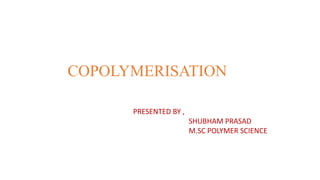
Copolymerisation
- 1. COPOLYMERISATION PRESENTED BY , SHUBHAM PRASAD M.SC POLYMER SCIENCE
- 2. A copolymer is a polymer formed when two (or more) different types of monomers are linked in the same polymer chain. Example :-nylon 66, polyurethane, PET etc. Copolymer :- Copolymerisation :- In copolymerisation , two or more monomers/monomer pair are polymerised simultaneously and hence the polymer is composed of more than one repeat unit. For example styrene –butadiene rubber (SBR) the firstly commercially made synthetic rubber . It is a copolymer obtained by free radical polymerisation of two monomer , styrene and butadiene.
- 3. Types of copolymer :- 1. Block copolymer :- Block copolymers consist of two or more strands (blocks) of different polymers chemically attached to each other. 2.Random copolymer :- It is comprised of more than one kind of repeating unit, in which there is a random distribution of repeating units. 3. Alternative copolymer :- Alternating copolymer. are composed of two monomers that alternate in sequence in the polymer chain. In an alternating copolymerization the two monomers M1 or M2 are unable to hompolymerize but do copolymerize.
- 4. 4. Graft copolymer :- It is a type of copolymer in which one or more blocks of homopolymer are grafted as branches onto a main chain, meaning it is a branched copolymer with one or more side chains of a homopolymer attached to the backbone of the main chain.
- 5. Free radical copolymerisation kinetics:- Step 1:-Initiation :-the free radical formed can attack M1 Or M2 Step 2 :- propagation
- 6. Now rate of all four types of propagation :- The basic assumption is that the reactivity of any growing chain depends only on the end monomer unit carrying the free- radicals site not in the no. of monomer units already added to the chain. The rate at monomer M1 and M2 are consumed during the course of propagation can be expressed as follows :-
- 7. Now , assuming a steady state wherein the rate of a particular chain end disappearing is equal to the rate of formation of the same chain end .
- 8. Combine the all equation
- 10. The copolymer formed depends on the monomer concentration and their reactivity ratios . Mole fraction of monomer present in copolymer and mole fraction of monomer feed n1 and n2 are the mole fraction of monomer M1 and M2 respectively , in the copolymer formed . N1 and N2 are the mole fraction of the monomer M1 and M2 respectively , in the monomer feed .
- 13. Copolymer equation 1.Mayo lewis method Where , denoted M1 / M2 by M, molar concentration ratio the monomer in the feed Denoted m1/m2 by P , molar concentration ratio the monomeric components in the polymer
- 14. 2.Fineman –ross method :- Fineman ross equation
- 15. Reactive ratios and copolymerisation behaviour:- a) When r1 = r2 =0 In this case the propagation types 11 and 22 are not possible and hence , a chain ending with M1 will add only an M2 and M2 will add only M1 and formed alternative compolymer. b) When r1 = r2 =1 In this case , all four types of propagation reaction are equally possible . This is ideal copolymerisation and formed random copolymer . c) When r1 ˃1 and r2˂ 1 in this case , the propagation reaction type 11 and 21 will be preffered to types 12 and 22 and hence, M1 entering into the copolymer chain is higher as compared to M2 d) When r1 ˂ 1 and r2 ˃ 1 the copolymer formed will , therefore , be richer in M2 . e) When r1 ˃ 1 and r2 ˃ 1 Such a system does not usually undergo random copolymerisation it form either mixture of two homopolymer or under Certain condition , block copolymer having long sequence of M1 followed by a long sequence of M2 .
- 16. Q-e scheme of alfery and price :- The method deals with the resosance stabilisation and polarisation characteristics of a monomer and predicts its reactivity behaviour wit reference to another monomer radical. Assuming that a monomer M2 adds on to a radical M1 the rate constant for the propagation reaction . Where , P1 denotes a factor charactersing the state of the radical M1 at the growing chain end Q2 indicates the resonance stability and hence the measure of the reactivity of the monomer M2 e1 and e2 is polarisation characteristics of monomer M1 and M2 Similarly ,
- 17. We know r1 = k11/k12 Q-e scheme suggest a) Monomers with widely differing Q value do not co polymerise b) Monomer having widely differing e value have tendency to form alternating copolymers c) Monomers having roughly equal Q value and almost identical e value will undergo azeotropic copolymerisation .
- 18. Ionic copolymerisation :- Ionic copolymerisation is same as free radical coplymerisation but reactivity is different as free radical copolymerisation because the reactivity ratio in free radical copolymerisation is dependent on temperature and monomers but while in ionic coploymerisation they are dependent not only on the monomer pair but also on the solvent and the initiator system used and also very much dependent on polarity of the polymerisation system . Free radical polymerisation using benzoyl peroxide yield a copolymer containing roughly 50% styrene. Cationic polymerisation initiated by borontrifluoride etherate copolymer containing more than 95% styrene . Anionic polymerisation with triphenly methyl sodium result in a copolymer having less than 5% styrene .
- 19. Thank you